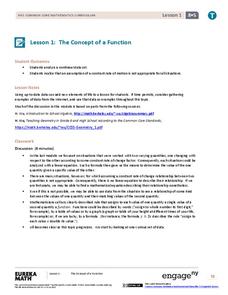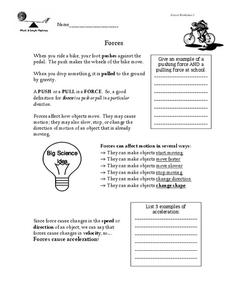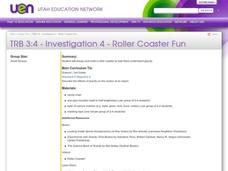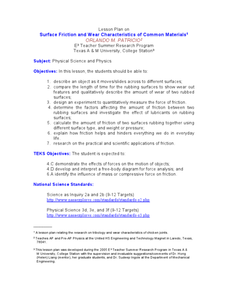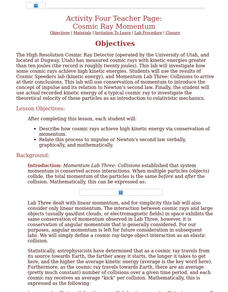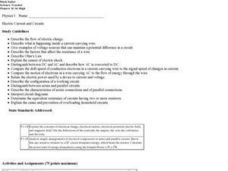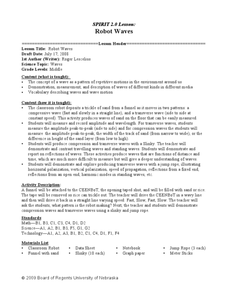EngageNY
The Concept of a Function
Explore functions with non-constant rates of change. The first installment of a 12-part module teaches young mathematicians about the concept of a function. They investigate instances where functions do not have a constant rate of change.
Curated OER
Avalanche!
Students explain that when forces on an object are balanced, the motion of object does not change. They describe how an object changes its motion when forces on it are unbalanced. They plan and conduct a scientific investigation to test...
Curated OER
Rocket Racer
Students design their racer then trace their designs onto Styrofoam tray and athen attache a balloon to a strw which is attached to the "car" to construct a rocket propelled "car." They collect data to determine the speed and the...
Alabama Learning Exchange
Energy and Work Amusement Park Style
Students distinguish between kinetic and potential energy. They recognize that energy can change from one form to other forms. They identify and describe several forms of energy.
Curated OER
Building a Roller Coaster
Students describe the law of conservation of energy. They identify the conversion between potential and kinetic energy. They investigate and describe the application of Newton's Laws of Motion.
Curated OER
Forces
In this forces worksheet, students read about force and acceleration. They complete a Venn Diagram to compare and contrast balanced and unbalanced forces, they answer questions about a diagram of a tug-a-war and the forces acting on each...
Curated OER
Matter and Energy
In this matter and energy worksheet, students identify substances as solids, liquids or gases, they use the kinetic theory to describe the motion of particles and they explain the conservation of mass and energy when a substance changes...
Curated OER
Automobile-Accident Reconstruction
Students investigate an accident and relate it to math. In this trigonometry lesson, students measure the accident scene, the friction produced, and the speed from the skid marks. They create a poster of their findings.
Curated OER
Walk the Line
Learners create constant speed versus motion graphs. They will perform linear regressions on their data to describe the graphs mathematically.
Curated OER
Roller Coaster Fun
Third graders review the effects of gravity on how objects move. In groups, they design a roller coaster and share it with their classmates. Using materials given to them, they build their roller coaster and let a ball roll on the...
Curated OER
What is a Wheel and Axle?
Stuents explore wheels and axles and how they maka machine move. After a teacher demonstration, young scholars construct a wheel and axle. Students explore the circumference of the wheel. They compare the wheel sizes, speed, distance,...
Curated OER
Surface Friction and Wear Characteristics of Common Materials
Students identify the factors affecting friction. In this physics lesson, students construct their own rocket car and race them. They graph the average speeds and discuss how lubricants affect friction between rubbing surfaces.
Curated OER
Cosmic Ray Momentum
Students describe how cosmic rays achieve high kinetic energy via conservation of momentum.
Curated OER
Space Shuttle Launch Trajectory-I
In this space shuttle launch worksheet, students are given 2 equations used to determine the space shuttle's trajectory in the first 5 minutes of a launch. Students use these equations to solve 3 problems including finding the shuttle's...
Curated OER
Numerical Determination of Drag Coefficients
Young scholars create a video of an object falling with a drag. In this physics instructional activity, students calculate drag coefficient using data from Logger Pro. They calculate velocity and acceleration of the object.
Curated OER
Time Trials
Students investigate speed, time and distance. In this algebra instructional activity, students utilize their knowledge of linear equations to solve problems related to time, speed and distance. This assignment is hands on using two toy...
Curated OER
Velocity, Acceleration, and Gravity
Students perform an experiment where a string is tied across the room. A straw is threaded onto the string, and a balloon attached to the straw. Students determine the speed of the balloon as it moves across the string. They repeat the...
Curated OER
Rock-A-Bye Pendulum
Third graders use the scientific process to explore the effects of force on an object in motion. They demonstrate that the greater the force applied to an object, the greater the change in speed or direction of the object. They...
Curated OER
Force/Newton's Laws/Friction
Students describe how to recognize a force, define balanced and net forces, state Newton's first law of motion, explain why friction works, state Newton's second Law of Motion, and explain why the direction of force is important.
Curated OER
Electric Current and Circuits
Compare the drift speed of conduction electrons in a current-carrying wire to the signal speed of changes in current. They also distinguish between DC and AC and describe how AC is converted to DC.
Curated OER
Newton's Second Law
In this Newton's law of motion activity, students review the concepts and equation associated with Newton's second law of motion. Students complete 7 matching and 5 true or false questions.
Curated OER
Atlatl Lesson Grades 4-12
Tenth graders explore the weapons of the Aboriginal people. In this tenth grade mathematics instructional activity, 10th graders investigate how throwing with an atlatl increase the speed of the dart as it is thrown. Students calculate...
Curated OER
Hang Time
Students simulate the motion of a fly ball with different winds. They use a partner to provide the simulated wind. Students draw a baseball diamond and the field on a piece of paper. They drag the pen across the paper to show the path of...
Curated OER
Robot Waves
Students differentiate the properties of longitudinal and transverse waves. For this physics lesson, students calculate CEENBoT's rate of propagation by measuring its frequency and distance per cycle. They use a mathematical formula...


